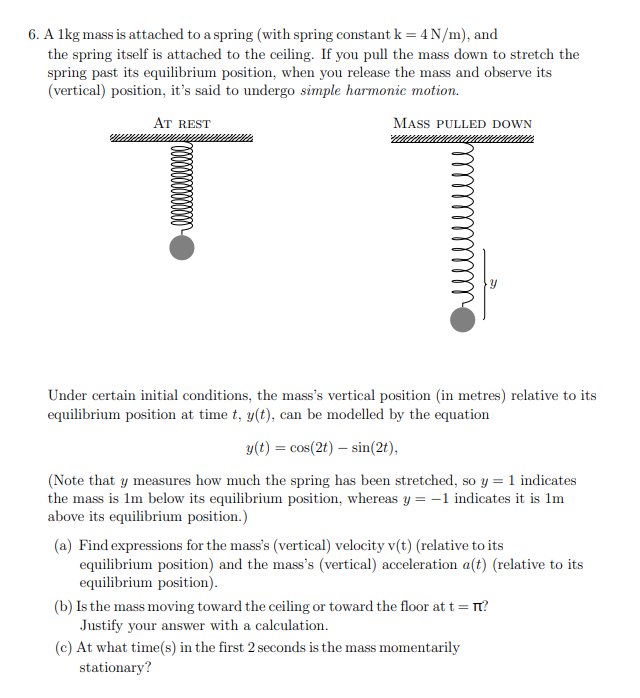(a) Find expressions for the mass's (vertical) velocity v(t) (relative to its equilibrium position) and the mass's (vertical) acceleration a(t) (relative to its equilibrium position). (b) Is the mass moving toward the ceiling or toward the floor at t = T? Justify your answer with a calculation.
(a) Find expressions for the mass's (vertical) velocity v(t) (relative to its equilibrium position) and the mass's (vertical) acceleration a(t) (relative to its equilibrium position). (b) Is the mass moving toward the ceiling or toward the floor at t = T? Justify your answer with a calculation.
Elements Of Electromagnetics
7th Edition
ISBN:9780190698614
Author:Sadiku, Matthew N. O.
Publisher:Sadiku, Matthew N. O.
ChapterMA: Math Assessment
Section: Chapter Questions
Problem 1.1MA
Related questions
Question

Transcribed Image Text:6. A 1kg mass is attached to a spring (with spring constant k = 4 N/m), and
the spring itself is attached to the ceiling. If you pull the mass down to stretch the
spring past its equilibrium position, when you release the mass and observe its
(vertical) position, it's said to undergo simple harmonic motion.
AT REST
MASS PULLED DOWN
wwww
Under certain initial conditions, the mass's vertical position (in metres) relative to its
equilibrium position at time t, y(t), can be modelled by the equation
y(t) = cos(2t) – sin(2t),
(Note that y measures how much the spring has been stretched, so y = 1 indicates
the mass is Im below its equilibrium position, whereas y = -1 indicates it is 1m
above its equilibrium position.)
(a) Find expressions for the mass's (vertical) velocity v(t) (relative to its
equilibrium position) and the mass's (vertical) acceleration a(t) (relative to its
equilibrium position).
(b) Is the mass moving toward the ceiling or toward the floor at t= T?
Justify your answer with a calculation.
(c) At what time(s) in the first 2 seconds is the mass momentarily
stationary?
Expert Solution
This question has been solved!
Explore an expertly crafted, step-by-step solution for a thorough understanding of key concepts.
Step by step
Solved in 4 steps with 4 images

Knowledge Booster
Learn more about
Need a deep-dive on the concept behind this application? Look no further. Learn more about this topic, mechanical-engineering and related others by exploring similar questions and additional content below.Recommended textbooks for you

Elements Of Electromagnetics
Mechanical Engineering
ISBN:
9780190698614
Author:
Sadiku, Matthew N. O.
Publisher:
Oxford University Press

Mechanics of Materials (10th Edition)
Mechanical Engineering
ISBN:
9780134319650
Author:
Russell C. Hibbeler
Publisher:
PEARSON

Thermodynamics: An Engineering Approach
Mechanical Engineering
ISBN:
9781259822674
Author:
Yunus A. Cengel Dr., Michael A. Boles
Publisher:
McGraw-Hill Education

Elements Of Electromagnetics
Mechanical Engineering
ISBN:
9780190698614
Author:
Sadiku, Matthew N. O.
Publisher:
Oxford University Press

Mechanics of Materials (10th Edition)
Mechanical Engineering
ISBN:
9780134319650
Author:
Russell C. Hibbeler
Publisher:
PEARSON

Thermodynamics: An Engineering Approach
Mechanical Engineering
ISBN:
9781259822674
Author:
Yunus A. Cengel Dr., Michael A. Boles
Publisher:
McGraw-Hill Education

Control Systems Engineering
Mechanical Engineering
ISBN:
9781118170519
Author:
Norman S. Nise
Publisher:
WILEY

Mechanics of Materials (MindTap Course List)
Mechanical Engineering
ISBN:
9781337093347
Author:
Barry J. Goodno, James M. Gere
Publisher:
Cengage Learning

Engineering Mechanics: Statics
Mechanical Engineering
ISBN:
9781118807330
Author:
James L. Meriam, L. G. Kraige, J. N. Bolton
Publisher:
WILEY